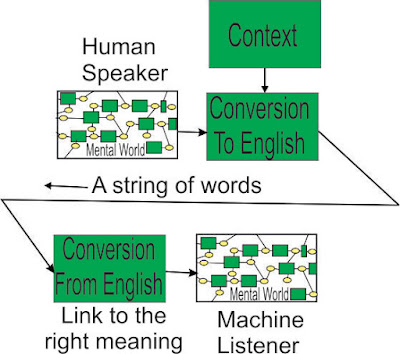Sending a Message Down This Long Distance Line
The two
sentences
A move by which a piece or pawn directly attacks the
opponent’s king.
If the defending player cannot counter the attack, the king
is checkmated.
work
together. An attack is described in terms of a verb and its subject and object.
Reference is
made in the second sentence to “the attack”, referencing the verb and its
subject and object in the first sentence. The object described by the noun
becomes the object of a relation (“countered”).
To know
whether the attack can be countered requires information from the first
sentence or its instantiation – the type of piece, and the positions on the
board of the piece and the king.
Countering
then becomes
·
Can
the piece be captured? – depends where the defending player’s other pieces are
·
Can
the direct path be blocked (doesn’t work for knights)?
·
Can
the king be moved out of harm’s way?
The
information has to be brought from the description of the attack.
This isn’t
the only possibility.
A move that causes a direct attack by a piece or pawn on the
opponent’s king.
We would
roll up the prepositions so we have an object which exactly matches the verb
equivalent. Should we create the verb equivalent as a simplification, or is
that unnecessary? If we want to activate it, is creating a verb the only way?
How does the
connection between the object in the two sentences work? – is there only a wire
between the two, and everything has to be rolled up into a message and sent down
the “long distance line”, or is a point of view (POV) transported to the site
of the relation (the noun “attack” functions as a portal to the verb “attacks”
or the noun “attack” in the first sentence).
Real neurons
only have conduction along directed “wires” between them, and yet we are not
aware of that, or it doesn’t impinge on our conscious understanding – it has
been airbrushed out. How? Possibly by doubling up, so everything can appear
undirected?
It is easy
to imagine that we have an operator which connects to the downstream “attack”
on Pin1 and then connects to every important node of the relation (how would we
know that?) in the first sentence. What happens when the verb is clausal, and
its object is a clause or assembly of clauses, and objects in the clause are
defined in a similar way – wouldn’t it explode on us? Or is this the dreaded
Four Pieces Limit?
It sounds
like – yes, it does explode. The text becomes “complex”.



Comments
Post a Comment